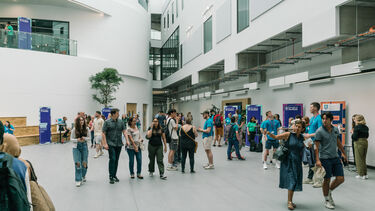Random Linguistics Musings #2 - The Fields of Linguistics
Linguistics! Whilst at school we learn the English language, there are two main methods of doing this. The first is for those that already know the language, and the second is for those that are somewhat or totally new to it.
We also have the analysis and discussion of the English Literature, of a great variety of texts throughout English histories, but this does not explain what Linguistics is. The field of Linguistics is the study not of how one should speak, listen to, read, or write the language, but more as the study of how it all actually works. It encompasses many great fields too, as all communication is essentially a form of linguistics – and I really can’t think of any academic field that does not involve communication… Simply put, linguistics is everywhere!
There’s morphology and syntax, which delve into word and sentence structure respectively, that reveal a great deal of underlying information about how we create bits that are longer than sounds that we know, but do not necessarily know. It’s subconscious and innate.
Semantics is another area that investigates the meanings of things and what they actually mean and touches upon truth and logic. There’s a philosophical linguistic field that studies why things should have the meanings and associations they do as well and the question of who their determiner is.
Phonetics is the study dealing with the acoustic output of language in the physical sound segments themselves and the anatomy of the human creating them. This field dips into both forensics and speech therapy.
Phonology is the flipside to this and focuses on the mental input of how language and its respective sound segments are stored within the brain and what relevant rules and constraints act upon them to cause different phonetic output.
The varieties of a language are also important, as different dialects have both differences in grammar and accent. Dialectology is the study that delves into understanding these differences and pinpointing how speakers of the same language, but a different social or geographic category, work linguistically or socially.
Similar to this is sociolinguistics, which analyses factors outside of the linguistic domain and focuses on social themes such as ethnicity, orientation, gender, age (to name a few), and how these factors affect the linguistic output of speakers.
Historical linguistics studies change in language over time instead of space (geography) or social categories and studies how similar language varieties may diverge into distinct languages where others may converge to more similar varieties and looks at accents and writing over time.
Acquisition is the field where the intake and learning of languages is studied and can sometimes be more commonly known as both child language learning, multilingualism and so on.
Pragmatics takes a look at turn-taking in conversations, the organisation of text, the implication and contexts of what is said, and also the subtext, which is of what is not said.
Stylistics dissects the spoken or literary language (which is known as discourse) used in regard to their linguistic and tonal interpretation, which relies upon the language variety or register the speaker/writer uses and their setting or situation.
Computational linguistics is the Avengers Assemble of all these elements and applies these linguistic fields to better ‘computer knowledge’ of languages. This requires a great amount of computational information to input all the various elements from all the various fields, and given that current computer knowledge of our everyday mobile phones is about that of three-year olds, we have a long way to go.
Forensic linguistics applies all of these fields to the policing world for interviews, recordings, and statements done to help limit the pool of possible victims, criminals, or witnesses, and gives a linguistic profile of the relevant people being scrutinised. This is often studied at postgraduate level and is usually an unthought of aspect of policing.
Typography, graphematics, and grammatology are the areas that look at the styling of writing, the elements of a writing system, and the way in which writing elements work with one another. These have been looked at in my previous series last semester, and it’s basically the linguistics of writing languages instead of speaking them.
There we have it. A relatively full look at many, but not all, fields of linguistics. It encompasses quite a large array of fields that, no doubt, all of us will find at least one or two of thoroughly interesting.
Linguistics, an introduction, is complete.
Next time, I shall be beginning a new miniseries…
Written by DP, Digital Student Ambassador, on 21 April 2022.

Experience Sheffield for yourself
The best way to find out what studying at Sheffield is like is to visit us. You'll get a feel for the atmosphere, the people, the campus and the city.

